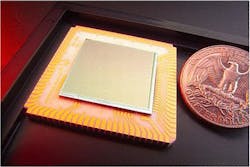Officials of the U.S. Army Contracting Command-Aberdeen Proving Ground, Belvoir Division (ACC-APG Belvoir) at Fort Belvoir, Va., have issued a sources-sought notice (W909MY14QIIIV) for the III-V Infrared Focal Plane Array Based Sensors program.
The source-sought notice, issued on behalf of the Army Night Vision and Electronic Sensors Directorate (NVESD) at Fort Belvoir, seeks companies able to provide technical support for developing III-V related sensor components.
Military applications of primary interest include wide-area overage for situational awareness; detection of plumes and gunflashes detection; infrared search, identification and tracking; missile detection and interception; and hyperspectral imaging.
Army researchers are interested in developing III-V superlattice large format, small pixel mid wave infrared (MWIR), long wave infrared (LWIR), and very long wave infrared (VLWIR), and dual-band (MW/LW, LW/LW, and short wavelength [SW]/LW) detector arrays.
Researchers also are interested in high-performance low cost III-V epitaxial wafers at increasing size; large gallium antimonide substrates with improved quality; advanced readout integrated circuits supporting advanced III-V detectors; FPA hybridization including small pixels, thermally compatible FPA packaging; and integrated cooler and dewar assembly (IDCA) units.
Responders should identify as many as three relevant contracts and describe specific engineering experience, knowledge, understanding, and expertise. The acquisition may be set-aside for small business, and participating contractors must have secret facility clearances.
Companies responding should be able to:
-- build and demonstrate antimony-based III-V long-wave infrared (LWIR), very-long-wave infrared (VLWIR) dual-color and dual-band infrared focal plane arrays;
-- develop custom lab and field testing components, infrared sensors, dewars, and packaging;
-- grow III-V antimony-based epitaxial materials affordably on large substrates;
-- design and build high-well-capacity analog readout integrated circuits (ROICs) for LWIR FPAs;
-- show repeatability in developing high-operating-temperature antimony-based III-V MWIR infrared focal plane arrays; and
-- improve the quality and uniformity of large gallium antimonide (GaSb) substrates.
Companies interested should email 20-page papers to the Army's Michelle Hodges no later than 19 Dec. 2013 at [email protected]. More information is online at https://www.fbo.gov/notices/45a41c39d0071d8b67614d589fd5df70.



